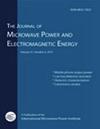Experimental investigation of radio frequency heating uniformity of wheat flour surrounded by deionized water and NaCl solution
IF 1.5
4区 工程技术
Q4 ENGINEERING, CHEMICAL
Journal of Microwave Power and Electromagnetic Energy
Pub Date : 2023-10-02
DOI:10.1080/08327823.2023.2269495
引用次数: 0
Abstract
AbstractThe present study proposes an approach to overcome the problem of corner/edge overheating of foods undergoing radio frequency heating. For testing, a container with a central rectangular compartment surrounded by a frame of four compartments was used. Wheat flour, a representative of low-moisture foods, was packed inside the rectangular compartment to provide a density of 800 kg/m3. Afterwards, in the surrounding compartments, air, deionized water and NaCl solution were used for independent radio frequency heating tests. Two different electrode gaps (135 and 145 mm) were employed. The temperature of the sample was measured continuously using fibre optic probes at four different internal locations. The difference between the maximum and the minimum temperatures for three different cases (a: air, b: deionized water and c: NaCl solution) were as follows for electrode gaps of 135 and 145 mm, respectively: (a) 27.3 and 26.1 °C, (b) 2.5 and 4.8 °C and (c) 3.7 and 1.8 °C. Uniformity index values were also calculated. The results showed that temperature variation within the sample was greatly reduced when the sample was surrounded by deionized water or NaCl solution.PRACTICAL APPLICATIONThe project findings will provide processors with a practical means to achieve more uniform radio frequency heating of low-moisture foods.Keywords: Radio frequency heatingheating uniformitywheat flourdeionized waterNaCl solution Disclosure statementNo potential conflict of interest was reported by the author(s).Additional informationFundingThis work was supported by the Scientific Research Projects Unit of Mersin University (Project no: 2019-3-TP3-3787), Council of Higher Education (100/2000 Doctoral Scholarship Programme) and Scientific and Technical Research Council of Turkey, TUBITAK (2211-A National Doctoral Scholarship Programme).去离子水和NaCl溶液包围小麦粉射频加热均匀性的实验研究
摘要本研究提出了一种解决射频加热食品边角过热问题的方法。为了进行测试,使用了一个中央矩形隔间的容器,周围是四个隔间的框架。小麦粉是低水分食品的代表,被包装在矩形隔间内,密度为800 kg/m3。随后,在周围隔间内,分别用空气、去离子水和NaCl溶液进行独立的射频加热试验。采用两种不同的电极间隙(135和145 mm)。使用光纤探针在四个不同的内部位置连续测量样品的温度。三种不同情况下(a:空气,b:去离子水,c: NaCl溶液)的最高和最低温度之差分别为:(a) 27.3和26.1°c, (b) 2.5和4.8°c, (c) 3.7和1.8°c。并计算了均匀性指数。结果表明,当样品被去离子水或NaCl溶液包围时,样品内部的温度变化大大减小。实际应用:该项目的研究结果将为加工者提供一种实用的方法,使低水分食品的射频加热更加均匀。关键词:射频加热加热均匀性小麦去离子水nacl溶液披露声明作者未报告潜在利益冲突。本研究得到梅尔辛大学科研项目部(项目编号:2019-3-TP3-3787)、土耳其高等教育委员会(100/2000博士奖学金项目)和土耳其TUBITAK科学技术研究委员会(2211-A国家博士奖学金项目)的支持。
本文章由计算机程序翻译,如有差异,请以英文原文为准。
求助全文
约1分钟内获得全文
求助全文
来源期刊

Journal of Microwave Power and Electromagnetic Energy
ENGINEERING, CHEMICAL-ENGINEERING, ELECTRICAL & ELECTRONIC
CiteScore
2.50
自引率
6.70%
发文量
21
期刊介绍:
The Journal of the Microwave Power Energy (JMPEE) is a quarterly publication of the International Microwave Power Institute (IMPI), aimed to be one of the primary sources of the most reliable information in the arts and sciences of microwave and RF technology. JMPEE provides space to engineers and researchers for presenting papers about non-communication applications of microwave and RF, mostly industrial, scientific, medical and instrumentation. Topics include, but are not limited to: applications in materials science and nanotechnology, characterization of biological tissues, food industry applications, green chemistry, health and therapeutic applications, microwave chemistry, microwave processing of materials, soil remediation, and waste processing.
 求助内容:
求助内容: 应助结果提醒方式:
应助结果提醒方式:


